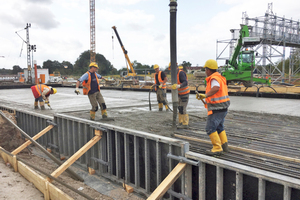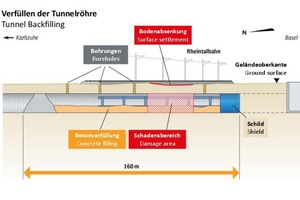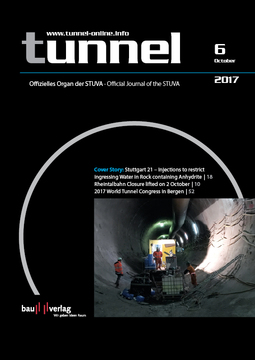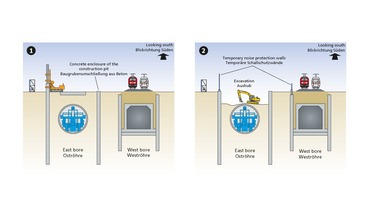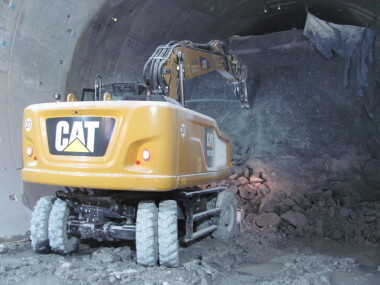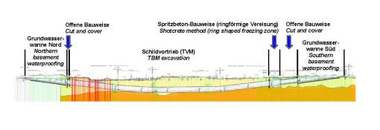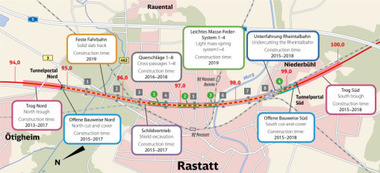Rheintalbahn Closure lifted on 2 October
On the morning of 12 August 2017, water and earth collapsed into the east bore of the Rastatt Tunnel in the course of construction works. The permanent way and tracks of the Rheintalbahn (Rhine valley line) above the tunnel settled by up to 30 cm in the affected area, since when the important main line between Rastatt and Baden-Baden has been closed for passenger and goods traffic; tunnelling works in the Rastatt Tunnel were also stopped immediately.
Segments displaced
Water and earth penetrated into the tunnel along a length of about 40 m after segments had displaced in the course of the mechanised tunnelling works in the east bore. In order to provide pre-support for tunnel driving at this location with shallow cover under the railway line, a ring of ground had first been frozen along a length of about 200 m, which, in this magnitude, represents an innovation in mechanised tunnelling.
Tunnel Backfilling and Repair of the Tracks
In order to stabilise the tunnel section under the Rheintalbahn, altogether 10 500 m³ of concrete was filled through seven boreholes along a length of 160 m. The TBM, which had cost 18 million euros, was also concreted in. Immediately after this, work started on removing the tracks and preparations for the construction of a concrete slab about 120 m long and 1 m thick, which served as the foundation for the relaying of the tracks on the affected section of the Rheintalbahn.
The originally optimistic estimation that the track closure could be lifted on 26 August had to be revised after a short time. A closure of the affected section of the Rheintalbahn lasting almost two months until 7 October was now planned. Together with the involved construction companies, German Railways DB managed to optimise the logistical deployment of personnel and machines once more so that the complete reopening of the Rheintalbahn could be brought forward to 2 October.
Replacement Services and Diversions
The cancelled passenger services – about 70 long-distance and 50 regional trains daily – had to be replaced with buses: up to 23 bendy buses carried approximately 3000 passengers between Rastatt and Baden-Baden each day. One important task was the organisation of diversions for goods trains until the section could be reopened. The Rheintalbahn is one of the main European goods routes, with up to 200 trains daily running on the north-south corridor between Karlsruhe and Basle.
As one of eleven construction measures revised at short notice for the most effective possible diversion of goods traffic, the early reopening of the Gäubahn on 7 September provided some relief. About 70 additional train drivers, some from railway companies in neighbouring countries, were deployed to drive goods trains – above all for the routes through France and South Germany. The additional costs of the rail diversions for DB and the affected companies amount to three figures of millions.
Continued Construction of the West Bore
Tunnelling works in the Rastatt Tunnel are continuing. DB and the Tunnel Rastatt joint venture have together developed a plan for the continuance of the project. Tunnelling works in the undamaged west bore are continuing, as DB already announced at the start of September.
“The improvement of the Rheintalbahn will provide considerably increased rail capacity on one of the most important European corridors. Continued construction is a clear signal: we stand behind this project”, says Prof. Dr. Dirk Rompf, chairman of large projects at DB Netz AG.
The tunnel boring machine Sibylla-Augusta had started work in the west bore in September 2016. At the moment, the machine is about 800 m away from the Rheintalbahn and will reach it in the next two or three months.
In order to be additionally safe for the second crossing of the Rheintalbahn, the project parties decided to construct a second concrete slab to stabilise the ground. The second bore will cross the line about 150 m north of the first crossing, and the second concrete slab will then additionally secure the tracks of the Rheintalbahn at this location.
“Investigation of the causes is still continuing. But we are taking a very safe route and literally installing a second floor”, says Dirk Rompf. The construction of the second concrete floor slab is being carried out parallel to the already progressing works on the first slab and will thus have no effect on the schedule.
According to DB, the east bore of the Rastatt Tunnel is going to be finished on the initially planned alignment. The remaining 40 m inside the freezing zone will be excavated by conventional means. The concrete filling under the Rheintalbahn tracks and the encased TBM have to be removed from the tunnel.
M. K./G. B.

